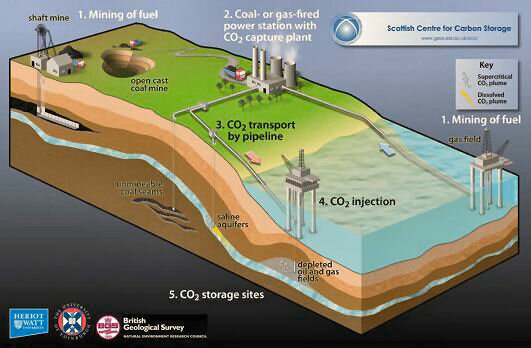Carbon capture and storage
Posted in Technology on 06/23/2009 08:26 am by Stephen TindaleCoal has a very high carbon content, so is a major source of greenhouse gasses and the economic costs of polluting the atmosphere are not borne by the polluter, In economic jargon, ‘the externalities are not internalised’. This obviously makes coal an attractive option for many energy companies. In addition, energy security – the extent to which a country is self-sufficient or has to import its energy – makes coal appealing to countries with major coal reserves. Europe increasingly relies on Russia for its gas, which is politically problematic, and the Russian-Ukrainian gas dispute earlier this year put energy security at the top of the political agenda.
Also high on the political agenda is fuel poverty. Those who have to spend more than 10% of their income on fuel are defined as ‘fuel poor’. In the UK, thousands die each year from cold. Many of these tragedies are caused by the price of gas, not electricity, so fuel poverty increases the social and political appeal of coal.
The US gets about half of its electricity from coal, as does Germany. The UK gets about 40%. And major developing nations are adding rapidly to the climate impact of this fuel. China gets 80% of its electricity from coal and India 70%. South Africa gets over 90%.
So, can coal be burnt in less damaging ways? It can certainly be used in a more efficient way, by using combined heat and power (CHP) technology. When it is burnt in a power stations, most of the coal’s energy simply goes up the chimney as heat. Ironically, at the same time, natural gas is used to provide heat for factories, offices and homes. Indeed, virtually half of the UK’s total carbon emissions are caused by the provision of heat for buildings. It follows that allowing heat to escape up power station chimneys make no economic or climate sense. Whenever coal (or gas or oil) is used to generate electricity, the heat should also be used.
Beyond CHP, it may be possible to capture the carbon emissions from power stations and store them underground or under the sea. If it works as expected and hoped, carbon capture and storage (CCS) will prevent up to 90% of these carbon emissions. However, CCS is not a fully proven technology. Parts of the process are: Norway has shown that it is possible to pump carbon into depleted gas fields (which helps to get more natural gas out). And small scale CCS plants are operating, but only up to 30Mw. Therefore, much larger demonstration projects must be built as soon as possible.
It is possible to store carbon dioxide underground, for example in old coal mines. Saline aquifers are another possible storage option and are being actively considered in China. Carbon dioxide is not toxic, but is heavier than air. When an enormous quantity of carbon dioxide escaped from Lake Nyasa in Cameroon, many thousands suffocated and died. So, putting it under the sea bed is preferable for countries with lots of coastline, which obviously includes the UK.
CCS can be used either before the coal is burnt – known as ‘pre-combustion’ – or after it is burnt – ‘post-combustion’. Pre-combustion is better for the climate, but cannot be retro-fitted to existing coal fired power stations. So post-combustion is essential to control emissions from power stations in the developing world. Therefore, both pre and post must be demonstrated.
A third approach is to burn the fuel in air enriched with oxygen, producing exhaust gas of CO2 and water vapour, which can easily be separated. This approach is known as oxyfuel. Oxyfuel technology can also be retrofitted. The largest oxyfuel demonstration projects operating today are a 40Mw new-build coal plant in Scotland, a 30Mw retrofitted gas plant in France and a 30Mw retrofitted coal plant in Germany. However, it is too soon to put all financial support into one technology. Therefore, post-combustion should also be funded, but on existing stations, not new capacity.
CCS can also be used for natural gas, as it is at Total’s demonstration scheme in France. It follows that pre and post-combustion schemes, and coal and gas schemes, should all be supported.


